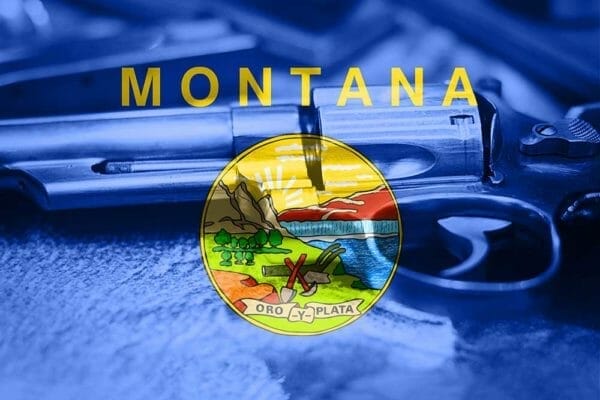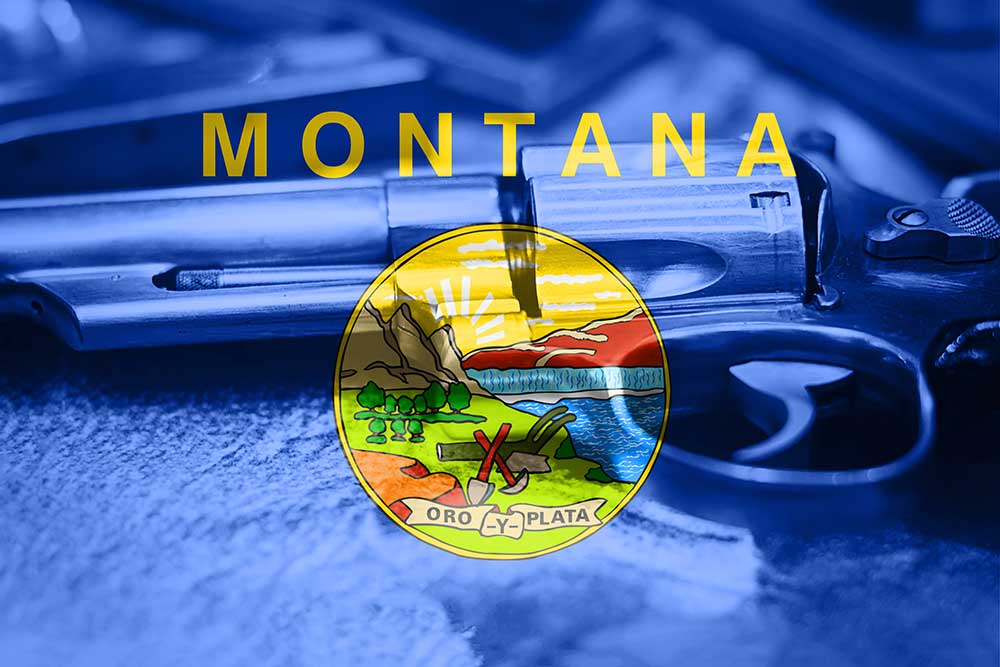
U.S.A. –-(AmmoLand.com)- Gary Marbut is an underappreciated mover and shaker in the movement to restore the right to keep and bear arms in the United States, particularly in Montana. Gary was a primary force in the front lines and behind the scenes, working hard to reform legislation, write legislation, and to keep harmful legislation from being passed. It is doubtful anyone in Montana or in the nation, is more knowledgeable about the state of law, regarding arms, and the people’s right to arms, in Montana than Gary.
I have admired Gary for many years. He founded the Montana Shooting Sports Association. His accomplishments are many. His tenacity in the face of adversity has been impressive. He has never given up, and he has achieved most of what he set out to do, 37 years ago.
Gary has written an impressive and authoritative explanation of what the passage of Montana bills LR-130 and HB 102 mean for Montana. It is well worth reading, in order to understand the law in Montana. I have included it below:
Effects of LR-130 and HB 102
An Explanation
by
Gary Marbut, president
Montana Shooting Sports Association (MSSA)
Author, Gun Laws of Montana
Legislative Referendum # 130 was approved by the voters of Montana and became effective on January 1, 2021. House Bill 102 was finally approved by the Montana Legislature on February 5, 2021. HB 102 was signed into law by Governor Gianforte on February 18, 2021. Most of HB 102 has an immediate effective date.
The Question
What changes have been made to Montana laws by LR-130 and HB 102, and what do those changes permit, prohibit, or require for Montana gun owners? Those are the questions this discussion will seek to answer.
If the reader wishes a more licensed opinion, consult a licensed attorney or the local county attorney. However, the author of this discussion wrote both LR-130 (HB 357 of the 2019 legislative session) and HB 102. This author feels competent to discuss the ramifications of these two measures.
This discussion of the effects of LR-130 and HB 102 has come to be longer than intended. However, the author believes that Montana gun owners want and need a complete understanding of the laws that apply to them.
Rather than explore the details of LR-130 and HB 102, this discussion will focus on the effect of the law after LR-130 and after HB 102. Still, the discussion must begin with a general explanation of LR-130 and HB 102.
Purpose of LR-130 and HB 102
The Purpose of LR-130 was to remove exceptions from Montana’s “preemption law” that had been abused by some local governments. Montana has had a preemption law at 45-8-351 since the 1980s, a law that generally prevents local government from regulating firearms. There have been some exceptions in 45-8-351 to allow local governments some limited authority to regulate firearms in certain places and for certain people. Some Montana local governments abused those limited authorities. The purpose of LR-130 was to remove from the law the exceptions that had been abused and thereby further restrict the authority of local government to regulate firearms.
The general purpose of HB 102 is to eliminate dangerous “gun free zones”, those places where only criminals would be armed because of a government prohibition that only law-abiding gun owners would obey. HB 102 has four major elements: Permitless carry, campus carry, restaurant and bar carry, and enhancement of existing concealed weapon permits (CWP), plus some minor elements.
Montana Constitution
This discussion must begin with the Montana Constitution. The right to keep or bear arms (RKBA) is a power the people have reserved to themselves from government interference at Article II, Section 12 of the Montana Constitution. This reserved right clearly applies to individuals, or as the Section 12 specifies, to “any person.” The reservation of right is specified to keep or bear arms in defense of any person’s “home, person, and property, or in aid of the civil power …” Section 12 says this right “shall not be called in question.” What “called in question” means is defined by the Legislature in Senate Joint Resolution 11 of the 2017 legislative session (another MSSA success).
There is an antique cultural relic left over from 1884 when the Montana Territorial Constitution was adopted that says that the reserved RKBA may not be “held to permit the carrying of concealed weapons.” This cultural relic was retained when the Territorial Constitution became the Statehood Constitution in 1889, and again with the rewrite of the Constitution in 1972. Thus, as long as this language is in the Montana Constitution, carrying concealed firearms is a privilege granted by the Legislature and not within the ambit of the reserved constitutional right.
As matter of historical interest, there are two reasons suggested for why the framers of the Territorial Constitution included the concealed carry exception in our RKBA. The first is that in 1884 it was considered culturally appropriate for an honest person to wear a firearm where it was observable and apparent, and that a hidden gun implied some nefarious purpose. The second reason suggested is that post-Civil War there was a lot of sentiment to prevent freed slaves from possessing arms. Many post-Civil War laws enforced this disarmament sentiment. Thus, if freed slaves possessed arms, it was usually wise for them to keep those arms hidden so as to not attract unwanted attention. Inclusion of this restriction on the RKBA in the 1884 Constitution may have been to further efforts to keep freed slaves disarmed and better expose them to the power of others with arms.
Regardless of the reason, this exception to our Montana RKBA still exists in the Montana Constitution. This is why what may be called “constitutional carry” in other states is more properly called “permitless carry” in Montana.
Finally, there is no exception in the RKBA at Article II, Section 12 for local governments to restrict this right, and no exception for the university system or the Board of Regents to restrict this right.
Types of “Carrying”
Because much of LR-130 and HB 102 is about bearing arms, or “carrying” firearms, it makes most sense to discuss three different types of carrying. Those are open carry (visible), concealed carry without a CWP, and concealed carry with a CWP. These will be referred to as “open”, “unpermitted concealed” or “permitless concealed”, and “permitted concealed”.
To further define this discussion, the reader should know that availability of and application process for CWPs remains unchanged. Plus, Montana recognizes permits issued by other states if the issuing state does a criminal records background check before issuing a CWP. And, it is worth restating the definition of “concealed” in Montana law as it pertains to firearms, which is “wholly or partially covered by clothing or wearing apparel.” In this context, briefcases, backpacks, and purses are considered to be luggage and not clothing.
Having established these several parameters, here is what Montana law will permit, require, or prohibit post LR-130 and post HB 102.
First, except for campus carry (discussed later), LR-130 is effective now and all parts of HB 102 have an immediate effective date. So, everything besides campus carry became effective the moment the Governor signed HB 102.
Local Rules
Local governments have very limited authority to regulate firearms in any way. More technically, this applies to all “subdivisions of the state” which includes cities, counties and districts within or between cities and counties. There are a lot of these districts which are government entities, such as urban transportation districts, special improvement districts, school districts, fire districts, grazing districts, irrigation districts, and many others.
A city or town may regulate the discharge of firearms. Additionally, there is a separate state law at 45-8-343 making it illegal to discharge a firearm inside city limits unless in self defense. Also, after LR-130, 45-8-351 now says, “A county, city, town, consolidated local government, or other local government unit has power to prevent and suppress the carrying of unpermitted concealed weapons or the carrying of unconcealed weapons to a publicly owned and occupied building under its jurisdiction.” This, by itself, doesn’t make it illegal to carry openly or unpermitted concealed into a publicly owned and occupied building, but it does give local governments the authority to adopt rules prohibiting this. Local governments have no authority over carrying by people with CWPs.
Permitless Carry
While Montana has had permitless carry in 99.4% of Montana since 1991, outside the limits of cities, HB 102 extends that successful experiment to inside cities. While CWPs are still available and have additional privileges (discussed below), a CWP is no longer necessary inside city limits, with a few exceptions. Note that permitless concealed carry only applies to a person who is “eligible to possess a firearm under state or federal law.” Plus, permitless concealed carry is not legal, per HB-102-revised 45-8-328, in “portions of a building used for state or local government offices and related areas in the building that have been restricted.”
It is no longer illegal or against any government rules to open carry, carry concealed without a permit, or carry concealed with a CWP, in a bank, a restaurant with a liquor license, or a bar.
Private Property
HOWEVER, a private property owner may prohibit firearms on his property. This includes banks, bars, restaurants, stores, and a host of other publicly accessible places that are privately owned. Certainly, any such places will be required to give “fair notice” of any firearms restrictions, usually by posting obvious signs. Some other states have laws such that if a gun carrier should walk past a no-guns sign on private property with a gun, that is a criminal offense. Not so in Montana.
But, if there is such a sign and private property policy in Montana, and the property owner or his agent (e.g., an employee) detects that a person is armed, the property owner or agent can certainly ask the gun carrier to leave and/or comply with the policy (just like “No shirt, no shoes, no service.”). If the gun carrier should refuse to comply, then the gun carrier’s continued presence becomes a matter of trespass, which IS a crime. This right of a private property owner to exclude firearms applies to open carry, unpermitted concealed carry, and permitted concealed carry.
Enhanced Concealed Weapon Permits
HB 102 declares that people with a valid CWP may not be prohibited from exercising their CWP except in a list of specified places. This new law doesn’t forbid permitted concealed carry in this list of places, but says permitted concealed carry may otherwise be prohibited in these places. NOTE WELL: This is not a list of “prohibited places” where the Legislature has forbidden exercise of a CWP. Rather, it is a list of places where the Legislature has allowed restriction on exercise of CWPs by another entity that has the authority to impose such a restriction. These places listed in the new law are:
1. In a correctional, detention, or treatment facility operated by or contracted with the department of corrections (e.g., prisons) or a secure treatment facility operated by the department of public health and human services (e.g., Warm Springs);
2. In a detention facility (jails) or secure area of a law enforcement facility (cop shops) owned and operated by a city or county;
3. At or beyond a security screening checkpoint regulated by the transportation security administration in a publicly owned, commercial airport;
4. In a building owned and occupied by the United States (e.g., federal courthouses);
5. On a military reservation owned and managed by the United States (e.g., Malmstrom AFB);
6. On private property where the owner of the property or the person who possesses or is in control of the property, including a tenant or lessee of the property, expressly prohibits firearms (discussed above);
7. Within a courtroom or an area of a courthouse in use by court personnel pursuant to an order of a justice of the peace or judge; and
8. In a school building as determined by a school board pursuant to 45-8-361.
Campus Carry
The thesis for campus carry is that although the Board of Regents is given considerable authority in Article X, Section 9, of the Montana Constitution to manage the affairs of the university system, it is given no authority whatsoever to suspend or abolish the rights the people have reserved to themselves from government interference in Article II of the Constitution.
The campus carry sections of HB 102 have an effective date of June 1, 2021. After that date, campus authorities may not regulate the possession of firearms on Montana university campuses if the firearm possessor is eligible to possess firearms and meets the minimum safety and training requirements required to apply for a CWP. That is, a campus carrier doesn’t need to actually have a CWP, but he or she must have satisfied the safety training needed to at least be eligible to apply for a CWP, safety training as listed in 45-8-321(3). This includes a list of optional types of firearm safety training that qualify. If a person already has a CWP, the person has met this criteria and qualifies for campus carry.
The university system is allowed a short and specific list of regulations it is allowed to impose on people about firearms on campus. NOTE: As with enhanced CWPs above, this is not a list of limitations that the Legislature has invoked for on campus. Rather, it is a limited list of restrictions that the Legislature believes may be realistically imposed on campus carry by campus authorities. The Legislature is saying, “Campuses may apply these restrictions, but no others.” This is the list of things campuses are allowed to prohibit or regulate:
1. The discharge of a firearm on or within university system property unless the discharge is done in self-defense;
2. The removal of a firearm from a gun case or holster unless the removal is done in self-defense or within the domicile on campus of the lawful possessor of the firearm;
3. The pointing of a firearm at another person unless the lawful possessor is acting in self-defense;
4. The carrying of a firearm outside of a domicile on campus unless the firearm is within a case or holster;
5. The failure to secure a firearm with a locking device whenever the firearm is not in the possession of or under the immediate control of the lawful possessor of the firearm;
6. The possession or storage of a firearm in an on-campus dormitory or housing unit without the express permission of any roommate of the lawful possessor of the firearm;
7. The possession or storage of a firearm by any individual who has a history of adjudicated university system discipline arising out of the individual’s interpersonal violence or substance abuse;
8. The possession of a firearm at an event on campus where campus authorities have authorized alcohol to be served and consumed; and
9. The possession of a firearm at an athletic or entertainment event open to the public with controlled access and armed security on site.
Note: As described above, cities are allowed to “prevent and suppress the carrying of unpermitted concealed weapons or the carrying of unconcealed weapons to a publicly owned and occupied building under its jurisdiction.” 45-8-351(2)(a). This may affect campus carry if a campus is inside city limits and if the city has adopted an ordinance asserting this local authority. If so, this will only affect inside buildings on campus.
In summary, if you are a student, a campus employee, or a visitor to campus, if you are eligible to possess firearms, and if you have had the training required to apply for a CWP, then you may possess a firearm on campus. Open and unpermitted concealed carry may be restricted inside campus buildings by a local city ordinance. Campus authorities are allowed to impose the following restrictions: You may not remove the firearm from a case or holster except in your campus domicile (no brandishing or show-and-tell) or discharge it except in self-defense; you may not point a firearms at another person except in self defense and you may not transport a firearm on campus unless in a holster or case; if you live in campus housing (e.g., dorms), you must have the permission of your roommate to keep a firearm there and the firearm must be secured with a locking device when you are not present; if you have been subject to adjudicated campus discipline because of violence or substance abuse, campus authorities may withdraw your ability to have a firearm on campus.
Finally, campus authorities may prohibit firearms at a campus event where serving and consumption of alcohol is authorized, or at athletic or entertainment events where access is controlled and armed security is provided.
It is worth noting that if a person is not a campus employee or a student, campus officials have no authority over that person. Campus officials have authority over employees and students because they can fire employees and expel students, or take lesser disciplinary measures against them. While it may be courteous for non-employees and non-students to abide by campus rules while on campus, there is no penalty in law for someone who is not an employee or student to not comply with campus policies while on campus.
Remedy
A person deprived of the right to carry under HB 102 may file a lawsuit against any government entity in district court. If the person prevails, the court may award court costs, attorney fees, and damages.
Additional Considerations
HB 102 also repeals an old and unnecessary law that prohibits carrying firearms on trains.
Under 45-8-361, K-12 school boards may prohibit guns in schools, including open carry, unpermitted concealed carry, and/or concealed carry. School boards may also allow guns in schools, such as for hunter education classes or for armed teachers who meet any criteria specified by the school board, such as having a CWP or with other training or conditions.
For technical and legal nerds, there are several ways that permitless carry could have been created with amendments to existing Montana law. Here is the way that was accomplished with HB 102. Pre-HB 102, 45-8-316 established the crime of carrying a concealed firearm. Then, 45-8-317 created a long and cumbersome list of people who were exempt from the crime created by 45-8-316. Those persons exempt included peace officers, people outside the limits of a city or town, people with CWPs, and a bunch more. HB 102 added one simple exception to 45-8-316 saying the crime of concealed carry doesn’t apply to anyone who is eligible to possess firearms, and then repealed all of 45-8-317 (that long list of exemptions which would no longer be needed). Because of that method of getting to permitless carry is why it has been awkward for some people reading HB 102 to identify where and how permitless carry was actually achieved in the bill. But, that was the cleanest way to update the law and accomplish what was needed. It leaves the resulting law easier for most people to read and understand.
The author reserves the prerogative to revise this discussion as needed.
End
Gary has done an admirable job of explaining the new laws.
About Dean Weingarten:
Dean Weingarten has been a peace officer, a military officer, was on the University of Wisconsin Pistol Team for four years, and was first certified to teach firearms safety in 1973. He taught the Arizona concealed carry course for fifteen years until the goal of Constitutional Carry was attained. He has degrees in meteorology and mining engineering, and retired from the Department of Defense after a 30 year career in Army Research, Development, Testing, and Evaluation.








+1 Thank you Gary
Now, all more restrictive states need to use Montana’s model to revise their own laws. Oklahoma, with “constitutional carry” and a pretty good CCW system, is pretty 2A friendly, but there are still too many dangerous “gun-free zones” and cities that abuse their power and add poorly-conceived restrictions. We need more campus-carry, too.
Hold on just a second. Did anybody note that this article uses hundreds and hundreds of words to explain Montanan’s weapons rights? All those words are just a field day for anti-gun lawyers and judges. Just read the referenced “Senate Joint Resolution 11 of the 2017 legislative session”. It somehow turns something as strongly written as “shall not be called in question”, in to something that has 10 or 20 ways that it CAN be called in question. Absolutely not ! ! ! I hold my similar Mississippi Constitutional right for open carry to “not be called in to question” to… Read more »
Our State Constitution was written in the 1800’s, and since you clearly have no understanding what that document says about our RKBA, suggest you read it.
“Section 12. RIGHT TO BEAR ARMS. The right of any person to keep or bear arms in defense of his own home, person, and property, or in aid of the civil power when thereto legally summoned, shall not be called in question, but nothing herein contained shall be held to permit the carrying of concealed weapons.” Yes, just about a duplicate of our Mississippi Constitution written in 1890. Yes, just what I thought it said. To what were you referring?
HLB
Maybe we should have written something like:
A well regulated Militia being necessary to the security of a free State, the right of the people to keep and bear Arms shall not be infringed.
I’m pleased with some of the things our MT legislature has been doing lately. More to go, like convention of states.